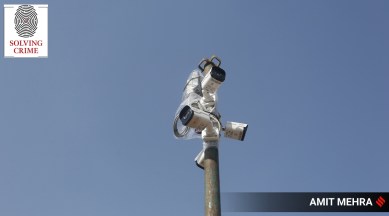Stay updated with the latest - Click here to follow us on Instagram
Solving Crime: How CCTV footage of a peeping Tom helped Mumbai police solve a physiotherapist’s rape-murder case
A Mumbai court convicted the accused and sentenced him to death. His appeal will be heard by the Bombay High Court.

The 2016 rape-murder of a 24-year-old physiotherapist in Mumbai initially saw the police scrambling for clues as the victim had been set on fire to destroy evidence. However, CCTV footage of a peeping Tom roaming around suspiciously in the area helped them crack the case.
On December 5, 2016, a 24-year-old physiotherapist hung out with her friends after work and before calling it a night, asked a friend to accompany her to her room to show her a new pair of shoes she had bought. The two friends sat engaged in a conversation and her friend left around 11.45 pm.
monthly limit of free stories.
with an Express account.
A few hours later, around 3.30 am, alert neighbours noticed smoke emanating out of her room and alerted her parents, who lived in a separate space below the room. They found the door bolted from the outside. They opened it and rushed inside to find books and clothes scattered in the room with smoke emanating from a heap. They also found the 24-year-old lying naked with jeans wrapped around her neck, strangling her. A neighbour called the police control room and the victim was rushed to the hospital but was declared ‘brought dead’.
The police soon confirmed through medical examination that the victim was raped and strangled before being set on fire to destroy any evidence left behind by the perpetrator. With no direct clues to establish the identity of the accused initially, the police took to looking through CCTV footage of buildings and shops in the nearby area.
A peeping Tom captured in CCTV cameras, looking into homes and roaming around suspiciously post-midnight in the area around the victim’s room was the prime suspect. The police showed the images around and the man was identified to be a goldsmith working in a jewellery shop nearby. When the police went to the shop, they were informed that the man was Debashish Dhara and he was a native of West Bengal. His employer told the police that he had left for his home claiming that he was needed to resolve a civil dispute there, four days after the incident. This settled the police’s suspicion.
Then followed other evidence. Dhara’s roommate told the police that on the night of the incident, he had returned to the room they shared behind the jewellery shop around 3.30 am and when he had asked why he was delayed, he did not answer and went to sleep. The co-worker also told the police that he usually returned home after dinner around 12.30 am. The police brought Dhara from his home and a DNA match with the samples drawn from the bedsheet in the victim’s home confirmed his presence at the spot of the incident.
During Dhara’s trial, where he was represented by a lawyer from the legal aid panel, he had claimed that he was falsely framed and that there was no evidence to show that he was seen at the victim’s home. He also claimed that he had gone to his native place in December 2016 as the jewellery business was affected by the demonetisation announced on November 8, 2016.
The special court relied on the testimony of the victim’s friend who had last seen her at 11.45 pm. She had said that while she left, she pulled the door of the victim’s room asking her to lock it from the inside. The police suspect that while peeping into homes, the accused found the door open and the victim fast asleep inside and entered to commit the crime. The court also relied on the testimonies of the accused’s co-worker and employer, the DNA sample, the medical evidence and the CCTV footage where the accused was seen peeping into homes in the area around the victim’s house.
Calling it a “barbaric” offence for the manner in which the crime was committed, a special court on October 4, 2019, sentenced Dhara to death. His appeal will be heard by the Bombay High Court.